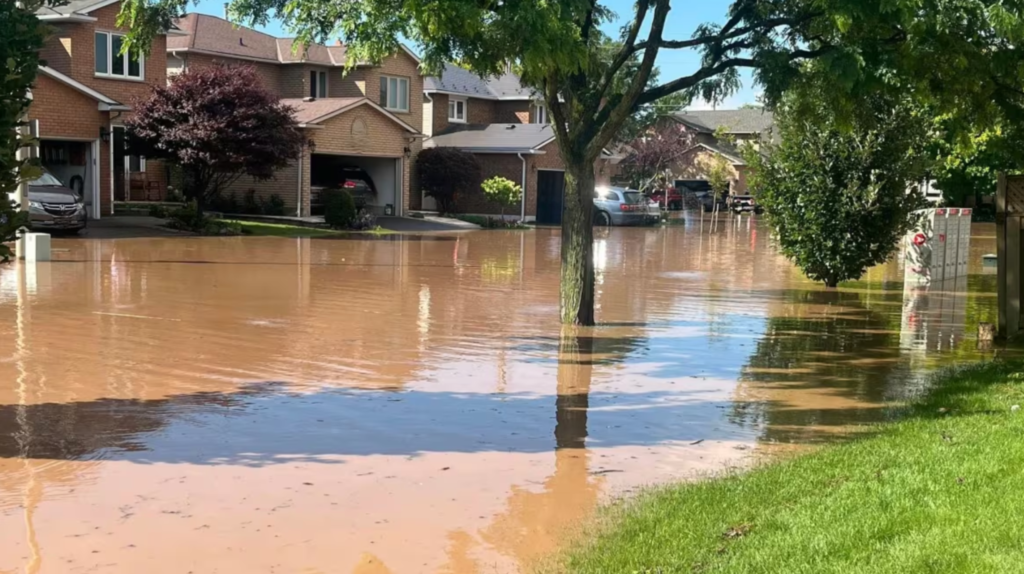Flood Preparedness: How to Protect Your Property Before, During, and After a Flood
Posted August 20, 2024

Flooding can strike with little warning, leaving homes and businesses vulnerable to extensive water damage. Recent events in the Greater Toronto Area and Montreal have highlighted the critical importance of being prepared for such disasters. As extreme weather becomes more frequent, it’s essential to know how to protect your property and ensure the safety of everyone in it. This guide outlines practical steps to take before, during, and after a flood, helping you stay ahead of potential damage and recovery efforts.
Before the Flood: Preparation is Key
- Assess Flood Risk
Start by understanding the flood risk in your area. Check flood maps, consult with local authorities, and consider the history of flooding in your neighbourhood. Knowing your risk allows you to take appropriate measures to protect your property. - Create a Flood Plan
Develop a comprehensive flood preparedness plan that includes evacuation routes, communication strategies, and a designated safe area within your home. Ensure every family member is familiar with the plan and practice it regularly. - Safeguard Important Documents
Store important documents like insurance policies, identification, and property deeds in a waterproof container. Consider keeping digital copies on a secure cloud service for easy access. - Install Flood Prevention Measures
Consider investing in flood barriers, sump pumps, and backflow valves to prevent water from entering your home. Ensure that gutters and drains are clear of debris to facilitate proper water drainage. - Check Your Insurance Coverage
Review your insurance policy to ensure it covers flood damage. If necessary, add flood insurance to your coverage, especially if you live in a high-risk area.
During the Flood: Safety First
- Stay Informed
Keep abreast of weather updates and emergency alerts through reliable sources. Follow the advice of local authorities and evacuate if instructed. - Turn Off Utilities
If flooding is imminent, turn off electricity, gas, and water supplies to prevent potential hazards. Ensure that all household members know how to do this safely. - Move to Higher Ground
If you’re unable to evacuate, move to the highest level of your home, bringing essential supplies with you. Avoid wading through floodwaters, as they may be contaminated or contain hidden dangers. - Communicate Your Whereabouts
Inform a trusted friend or family member of your location and stay in touch as much as possible. Use a battery-powered radio to stay informed in case of power outages.
After the Flood: Recovery and Restoration
- Ensure Safety First
Before re-entering your property, ensure that it is safe to do so. Check for structural damage, gas leaks, and potential electrical hazards. If in doubt, consult with professionals. - Document the Damage
Take photographs and videos of the flood damage for insurance purposes. Make a detailed inventory of affected items, noting their condition and value. - Initiate the Clean-Up Process
Begin by removing water and drying out your property as quickly as possible to prevent mould growth and other secondary damage. Dispose of contaminated items, and clean and disinfect all surfaces thoroughly. - Contact Your Insurance Provider
Notify your insurance company immediately to start the claims process. Provide them with the documentation of damages and keep records of all correspondence. - Seek Professional Help
Flood damage can be extensive and complex. Enlisting the support of professional restoration services, like those provided by EMRG members, ensures that the recovery process is handled efficiently and effectively. Local EMRG members are vetted and equipped with the necessary expertise to support you in restoring your property to its pre-flood condition.
Final Thoughts
Floods are unpredictable, but with the right preparation and response, you can mitigate the damage and protect your property. The recent floods in Ontario and Quebec are a reminder of the importance of being proactive in flood preparedness. Remember, safety is paramount, and when it comes to restoring your property, you’re not alone—EMRG members are here to support you every step of the way.
By following these guidelines, you can take control of your flood response and recovery, ensuring that your home or business is protected against future floods. Stay safe, stay informed, and don’t hesitate to reach out for professional help when needed.
